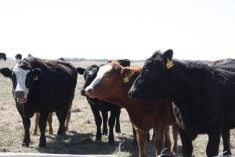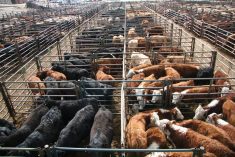BANFF, Alta. — New regulations for medicated animal feed could be in place this year.
The Canadian Food Inspection Agency has been working with the feed and animal industries for seven years to develop a workable set of regulations.
“The regulations in themselves are very general,” said Linda Morrison of the CFIA during a pork seminar held in Banff Jan. 25.
The regulations do not set out specific guidelines, such as recommended mixing equipment or scales required by feed manufacturers. These are addressed in a procedures manual that will be more specific.
Read Also

Canada told trade crisis solutions in its hands
Canadians and Canadian exporters need to accept that the old rules of trade are over, and open access to the U.S. market may also be over, says the chief financial correspondent for CTV News.
The regulations will be tested this spring in a pilot project at three different locations. Results are expected by the first week of April.
Regulations come under the Health of Animals Act and will be enforced by Health Canada and the CFIA.
Health Canada is responsible for approving new veterinary drugs and supplementary approvals, while CFIA is in charge of verifying and monitoring products.
CFIA has the power to remove products that violate the regulations. It also monitors “off label” use, such as giving drugs to species not specified on the label, or giving dosages that are different from what’s instructed on the label.
The government says the regulations are meant to protect animal and human health.
Feed with too much or not enough medication may be harmful or ineffective for livestock. Some meat consumers may suffer allergic reactions to certain drug residues. Overuse of certain medications may contribute to antibiotic resistance.
“The role of feed and drugs cannot be underestimated,” Morrison said.
Several stages
There will be a three-year phase-in period for manufacturers to comply with the regulations once they are approved: feed mills will have to be licensed in the first year; farms that use concentrated drugs in the second year; and farms that use pre-mixed feed and supplements in the third year.
Feed manufacturing standards under the plan include:
- Collected dust, reworked product, returns and recalls that are contaminated by drugs must be disposed of or used only in feed containing the same drug.
- Feed must be made by sequential production unless equipment is cleaned or flushed between batches of feed.
- An inventory must be kept of medicating ingredients and medicated feeds used to make other feeds. A lot number or date of manufacture must identify all lots of feed for sale.
- If an operator discovers a discrepancy with medicating ingredients or suspects contamination, the operator must stop selling the product, promptly investigate and take corrective measures.















